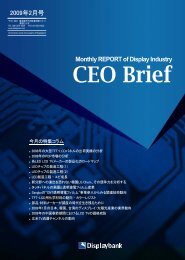Solar Grade-Silicon, Ingot, Wafer Technology and ... - Displaybank
Solar Grade-Silicon, Ingot, Wafer Technology and ... - Displaybank
Solar Grade-Silicon, Ingot, Wafer Technology and ... - Displaybank
You also want an ePaper? Increase the reach of your titles
YUMPU automatically turns print PDFs into web optimized ePapers that Google loves.
<strong>Solar</strong> <strong>Grade</strong>-<strong>Silicon</strong>, <strong>Ingot</strong>, <strong>Wafer</strong> <strong>Technology</strong> <strong>and</strong> Market Trend (2008~2012)<br />
important factor in determining silicon’s quality <strong>and</strong> unit cost. The poly-silicon<br />
is categorized into powder (dust-like) type which is smaller than several tens of<br />
um, granular type with several mm, <strong>and</strong> chunk (chip) type which is greater<br />
than several cm.<br />
For instance, the dust-like type manufactured by so-called free space method<br />
has the most effect on manufacturing cost cut among chemical methods using<br />
gas reactions. On the other h<strong>and</strong>, it has a shortcoming that it is difficult to<br />
regulate processes while melting silicon to grow crystals, which is a<br />
subsequent process, due to large specific surface areas <strong>and</strong> low density.<br />
Hence, the granular or chunk types appear proper considering subsequent<br />
processes. The granular type poly-silicon has a high filling density of crucible<br />
during crystal growth <strong>and</strong> enables continuous processes through fixed supply,<br />
but it also has large specific surface areas that it is difficult to h<strong>and</strong>le since it is<br />
easily contaminated by external environments. The poly-silicon manufactured<br />
by Siemens method is mostly chunk type. This type is easy to h<strong>and</strong>le in<br />
process, but has a low crucible filling density.<br />
The most important physical property of the poly-silicon is purity. The<br />
concentration of impurities within the poly-silicon has the biggest effect on the<br />
efficiency of solar cells <strong>and</strong> is the most critical variation in determining<br />
SAMPLE<br />
manufacturing costs. Impurities included within the silicon interior are generally<br />
divided into metal impurities <strong>and</strong> non-metal impurities. Major metal impurities<br />
include Fe, Al, Ti, Ca, Na, Zn, <strong>and</strong> Cu. Their inclusions may vary upon the<br />
initial silica materials <strong>and</strong> metallurgical silicon manufacturing processes. The<br />
poly-silicon must only include less than 1ppba metal impurities like the figure<br />
below in order to be used in solar cells.<br />
The second method creates trichlorosilane through metallurgical silicon <strong>and</strong><br />
hydrogenation processes.<br />
All Contents of this report remain the property of <strong>Displaybank</strong><br />
Jan’09











